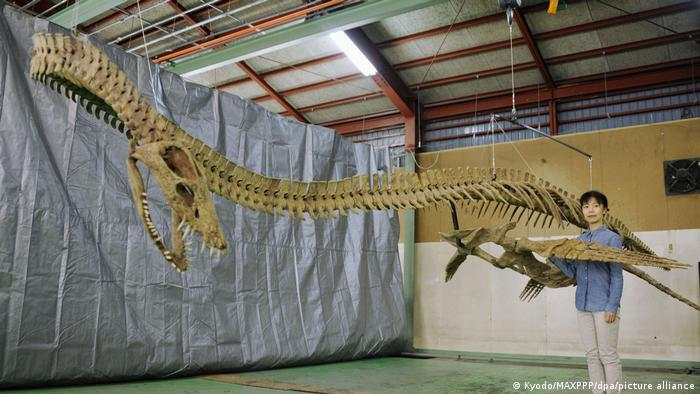Discovery of dinosaur remains revives controversy over 'Loch Ness monster'
Recently found remains of plesiosaurs may open the door again to the possibility of the Loch Ness monster. The study links the plesiosaurs that evolved from life in salt water to life in rivers with the freshwater lake monster.

The study confirmed that the plesiosaur, which was thought to live only in salt water, lived for long periods in fresh water
A new study shows that the plesiosaur - a dinosaur previously thought to live only in salt water - spent most of its life in fresh water.
This discovery is likely to fuel the convictions of some who believe in the existence of a monster living in Loch Ness , who have been seeking for centuries to prove that the legend is true, as some claim that the "Ness monster" was a descendant of the plesiosaur.
The paleontologist and lead author of the study, published in the journal Cretaceous Research , said:Nick Longrich, told CBS News: "As a scientist, I can never say anything is impossible. All hypotheses are on the table at some level until proven wrong."
Longrich said a team of paleontologists from the University of Bath, the University of Portsmouth in the UK and Hassan II University in Morocco had discovered "a lot of different plesiosaur fossils" within a 100-million-year-old river system that is now part of Morocco and the Sahara region. "A bit surprising."
Scientists say that since this type of dinosaur was known to live in salt water only, the discovery of its remains in an area known as the presence of fresh water, and the hypothesis that the Loch Ness monster is a descendant of the plesiosaur, the possibility of the existence of this monster in fact is a matter of thought, although All research and studies conducted on the lake to date have proven that there were no dinosaurs in it in any way.

A picture published by the Daily Mail on April 21, 1934 of the Loch Ness monster was revealed to be a hoax in 1999.
"The fossilized remains indicate that this group of animals was able to exploit and live in freshwater environments," Longrich said.
The scientists said that the fossils that were found included the bones and teeth of adult animals and the remains of one small animal, scattered in different places, indicating where the animals died as well as the place where they lived collectively.
"We found a lot of fossils that indicate these animals were routinely found there and may have spent much - if not all - of their lives in freshwater," Longrich said.
Some believers in the centuries-old story of the Loch Ness monster say the mysterious creature was last seen alive in the fresh waters of Loch Ness in the Scottish Highlands. But some scientists are skeptical that a dinosaur that lived millions of years ago could survive in the dark, frozen waters of the lake, which formed just 10,000 years ago during the Ice Age, according to the Science Daily website.

The study indicates that this group of dinosaurs was able to exploit and live in freshwater environments
The latest discovery also indicates that the last plesiosaurs became extinct around the same time, like the rest of the dinosaurs 66 million years ago, which contradicts the claims of some Loch Ness believers who say the creature was last seen alive in 1975.
"We could find the Loch Ness monster tomorrow," Longrich said. "It could be a plesiosaur....However, the possibility is very remote given the evidence we have at this point."
However, the paleontologists said the possibility that the study might make a connection between the plesiosaur and the so-called Loch Ness monster was a "reasonable" possibility.

https://www.dw.com/ar/%D8%A7%D9%83%D8%AA%D8%B4%D8%A7%D9%81-%D8%A8%D9%82%D8%A7%D9%8A%D8%A7-%D8%AF%D9%8A%D9%86%D8%A7%D8%B5%D9%88%D8%B1-%D9%8A%D8%B9%D9%8A%D8%AF-%D8%A7%D9%84%D8%AC%D8%AF%D9%84-%D8%AD%D9%88%D9%84-%D9%88%D8%AD%D8%B4-%D8%A8%D8%AD%D9%8A%D8%B1%D8%A9-%D9%84%D9%88%D8%AE-%D9%86%D9%8A%D8%B3/a-62822994?fbclid=IwAR1E3tEMsSSngU8XAniuAouncrAAhmCCY4usOyCs9bJnH1heGZPPDL0B-XU

